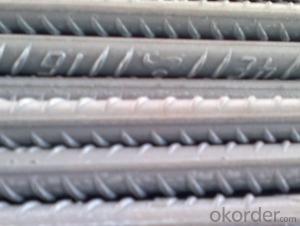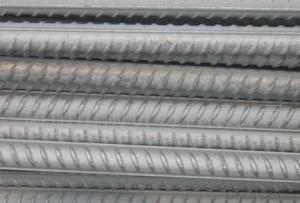HRB400 deformed bars with competitive price
- Loading Port:
- Tianjin
- Payment Terms:
- TT OR LC
- Min Order Qty:
- 25 m.t.
- Supply Capability:
- 100000 m.t./month
OKorder Service Pledge
OKorder Financial Service
You Might Also Like
Product Description:
Specifications of HRB400 Deformed Steel Bar:
Standard | GB | HRB400 | |
Diameter | 10mm-32mm | ||
Length | 6M, 12M | ||
Place of origin | Hebei, China mainland | ||
Advantages | exact size, regular package, chemical and mechanical properties are stable. | ||
Type | Hot rolled deformed steel bar | ||
Chemical Composition: (Please kindly find our chemistry of our material based on HRB400 as below for your information)
Grade | Technical data of the original chemical composition (%) | ||||||
C | Mn | Si | S | P | V | ||
HRB400 | ≤0.25 | ≤1.60 | ≤0.80 | ≤0.045 | ≤0.045 | 0.04-0.12 | |
Physical capability | |||||||
Yield Strength (N/cm²) | Tensile Strength (N/cm²) | Elongation (%) | |||||
≥400 | ≥570 | ≥14 | |||||
Theoretical weight and section area of each diameter as below for your information:
Diameter(mm) | Section area (mm²) | Mass(kg/m) | Weight of 12m bar(kg) |
18 | 254.5 | 2.00 | 24 |
20 | 314.2 | 2.47 | 29.64 |
22 | 380.1 | 2.98 | 35.76 |
Usage and Applications of HRB400 Deformed Steel Bar:
Deformed bar is widely used in buildings, bridges, roads and other engineering construction. Big to highways, railways, bridges, culverts, tunnels, public facilities such as flood control, dam, small to housing construction, beam, column, wall and the foundation of the plate, deformed bar is an integral structure material. With the development of world economy and the vigorous development of infrastructure construction, real estate, the demand for deformed bar will be larger and larger..
Packaging & Delivery of HRB400 Deformed Steel Bar:
Packaging Detail: products are packed in bundle and then shipped by container or bulk vessel, deformed bar is usually naked strapping delivery, when storing, please pay attention to moisture proof. The performance of rust will produce adverse effect.
Each bundle weight: 2-3MT, or as required
Payment term: TT or L/C
Delivery Detail: within 45 days after received advanced payment or LC.
Label: to be specified by customer, generally, each bundle has 1-2 labels
Trade terms: FOB, CFR, CIF



*If you would like to get our price, please inform us the size, standard/material and quantity. Thank you very much for your attention.
- Q: What are the factors that can affect the lifespan of steel rebars in concrete structures?
- Several factors can impact the lifespan of steel rebars in concrete structures. Firstly, the structure's concrete quality and composition are significant. If the concrete is of low quality or contains harmful chemicals, it can corrode the rebars, leading to a shorter lifespan. During construction, it is essential to properly proportion and cure the concrete mixture. Secondly, the rebars' lifespan is greatly affected by the exposure conditions of the concrete structure. Factors like humidity, temperature fluctuations, and the presence of aggressive substances such as chloride ions or carbon dioxide can accelerate corrosion. Structures in coastal or industrial areas are especially vulnerable due to high salt levels in the air or pollutant presence. Thirdly, the design and construction practices employed have a significant impact on rebars' longevity. Adequate cover thickness, which is the distance between the rebar surface and the concrete's outer face, is crucial. Insufficient cover thickness can result in inadequate corrosion protection. Additionally, effective drainage systems should be incorporated into the design to prevent water accumulation around the rebars, as stagnant moisture accelerates corrosion. Furthermore, maintenance practices also affect rebars' lifespan. Regular inspections, cleaning, and repairs help identify and address issues before they worsen. The application of protective coatings or the use of corrosion inhibitors can also extend rebars' lifespan. Lastly, the type and quality of the rebars themselves are important factors. Rebars with higher carbon and alloying elements are generally more resistant to corrosion. The manufacturing process quality and the presence of impurities can also impact rebars' durability. In conclusion, the lifespan of steel rebars in concrete structures can be influenced by several factors, including concrete quality, exposure conditions, design and construction practices, maintenance, and rebars' quality. Proper attention to these factors ensures the longevity and structural integrity of concrete structures.
- Q: What is the maximum tensile force of 25 thread steel?
- First of all, to know the brand of thread steel, such as: HRB335, HRB400, HRB500. No matter what the diameter of the thread steel is, the yield strength and tensile strength are the same as for the same grade of thread steel.
- Q: What is the cost of steel rebars?
- The cost of steel rebars can vary depending on factors such as the size, grade, quantity, and location of purchase. It is recommended to contact suppliers or check with local construction material stores for accurate and up-to-date pricing information.
- Q: How do steel rebars contribute to the fire resistance of concrete?
- Steel rebars contribute to the fire resistance of concrete in several ways. Firstly, steel has a high melting point and is a non-combustible material, which means it does not burn or add fuel to a fire. This property of steel rebars helps prevent the spread of fire and provides structural stability to the concrete during a fire event. Additionally, steel rebars act as a reinforcement within the concrete, enhancing its overall strength and load-bearing capacity. This reinforcement helps to prevent the concrete from cracking or breaking apart under high temperatures caused by a fire. The presence of steel rebars also improves the ductility of the concrete, allowing it to deform and absorb energy during a fire, rather than shattering or collapsing suddenly. Moreover, the thermal conductivity of steel is higher than that of concrete, meaning it can conduct heat away from the fire zone more effectively. This helps to dissipate heat and prevent it from reaching critical levels that could compromise the structural integrity of the concrete. By absorbing and distributing heat, steel rebars help to slow down the rate of temperature rise within the concrete during a fire. In summary, steel rebars contribute to the fire resistance of concrete by providing structural stability, enhancing strength and load-bearing capacity, improving ductility, and dissipating heat. These properties make concrete structures reinforced with steel rebars more resilient and capable of withstanding fire events for a longer duration, thereby increasing the safety of occupants and reducing potential property damage.
- Q: Can steel rebars be used in architectural concrete elements?
- Indeed, architectural concrete elements can incorporate steel rebars for reinforcement, thereby augmenting the strength and longevity of the structure. It is customary to employ steel rebars in concrete construction as they fortify the concrete and enhance its durability. In the realm of architectural concrete, rebars can be tactically positioned to fortify the structural integrity of the elements, while simultaneously contributing to their visual appeal. Depending on the desired design outcome, these rebars can either be visibly exposed or discreetly concealed within the concrete. By utilizing steel rebars, architects possess the versatility to fashion intricate and distinctive architectural elements, all the while ensuring the requisite strength and stability.
- Q: What is the maximum allowable stress for steel rebars?
- The maximum allowable stress for steel rebars is typically determined by the relevant building codes and design standards. It can vary depending on factors such as the grade and type of steel used, the intended application, and the specific design criteria.
- Q: Can steel rebars be used in highway barrier construction?
- Indeed, highway barrier construction does allow for the utilization of steel rebars. In fact, steel rebars are frequently employed as a means of reinforcing concrete structures, including highway barriers. By doing so, they grant the barriers with both strength and durability, rendering them capable of withstanding the forceful impact of vehicles and preventing any potential crossover into opposing lanes or off the roadway. It is worth noting that steel rebars possess notable attributes such as high tensile strength and exceptional resistance to corrosion, thus making them particularly suitable for highway barriers that are regularly subjected to adverse weather conditions and substantial traffic loads. Furthermore, steel rebars are easily obtainable and cost-effective, further solidifying their status as the preferred choice for highway barrier construction.
- Q: How are steel rebars tested for quality and strength?
- Steel rebars are tested for quality and strength through various methods such as visual inspection, dimensional checks, chemical composition analysis, and mechanical testing. Visual inspection ensures that there are no visible defects or irregularities on the surface. Dimensional checks verify that the rebars meet the specified size and shape requirements. Chemical composition analysis determines the elemental composition of the steel, ensuring it meets the required standards. Mechanical testing involves subjecting samples to tension, bending, or impact tests to assess their strength and confirm they can withstand the expected loads.
- Q: How are steel rebars used in retaining walls?
- Steel rebars are commonly used in retaining walls to provide additional strength and reinforcement. They are typically placed horizontally within the concrete structure to prevent cracking and improve the wall's structural integrity. The rebars help distribute the load and resist the pressure exerted by the retained soil, ensuring the stability and durability of the retaining wall.
- Q: Can steel rebars be used in the construction of sports stadiums or arenas?
- Certainly, the utilization of steel rebars in the construction of sports stadiums or arenas is a viable option. These rebars are frequently employed as reinforcement in concrete structures due to their impressive tensile strength and durability. Their suitability for extensive projects, such as sports stadiums, is evident. By providing extra support and stability, the rebars enable the concrete to withstand the immense loads and forces that occur during events in stadiums and arenas. Moreover, the versatility of steel rebars allows for effortless shaping and bending to match the specific design requirements and needs of the structure, making them an adaptable choice in construction endeavors.
Send your message to us
HRB400 deformed bars with competitive price
- Loading Port:
- Tianjin
- Payment Terms:
- TT OR LC
- Min Order Qty:
- 25 m.t.
- Supply Capability:
- 100000 m.t./month
OKorder Service Pledge
OKorder Financial Service
Similar products
Hot products
Hot Searches
Related keywords


























